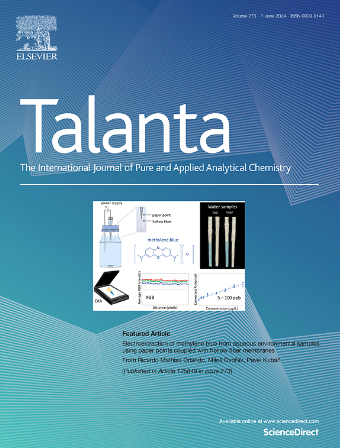An ultrasensitive flexible biosensor enabled by high-performance graphene field-effect transistors with defect-free van der Waals contacts for breast cancer miRNA fast detection
IF 5.6
1区 化学
Q1 CHEMISTRY, ANALYTICAL
引用次数: 0
Abstract
MicroRNAs (miRNAs) present in bodily fluids such as blood, saliva, and urine hold significant potential for both diagnosing and prognosing breast cancer. However, the development of flexible wearable field-effect transistor (FET) breast cancer miRNA biosensors still faces many challenges. Herein, we developed an ultrasensitive flexible biosensor based on a high-performance FET with defect-free van der Waals contacts for breast cancer miRNA fast detection. The flexible biosensor achieves a limit of detection (LOD) as low as 1.92 fM, a wide linear detection range of 10 fM–100 pM, and a short detection time of 10 min for fast detection of miRNA-155, which is approximately a 5-fold lower LOD compared to conventional graphene FET biosensors. Additionally, the sensor maintains stable sensing performance even after 100 bending/relaxation cycles. The defect-free graphene channel and excellent electrical properties of the flexible FET contribute to the high performance of the biosensor. The biosensor effectively differentiates miRNA levels in serum between breast cancer patients and healthy individuals, proving the possibility of practical application. It also successfully detects miRNA in sweat by attaching the biosensor to the human body, demonstrating its promise for non-invasive health monitoring as a wearable device. This easy-to-fabricate, high-performance flexible biosensor advances cancer biomarker analysis and wearable health monitoring technology.

求助全文
约1分钟内获得全文
求助全文
来源期刊

Talanta
化学-分析化学
CiteScore
12.30
自引率
4.90%
发文量
861
审稿时长
29 days
期刊介绍:
Talanta provides a forum for the publication of original research papers, short communications, and critical reviews in all branches of pure and applied analytical chemistry. Papers are evaluated based on established guidelines, including the fundamental nature of the study, scientific novelty, substantial improvement or advantage over existing technology or methods, and demonstrated analytical applicability. Original research papers on fundamental studies, and on novel sensor and instrumentation developments, are encouraged. Novel or improved applications in areas such as clinical and biological chemistry, environmental analysis, geochemistry, materials science and engineering, and analytical platforms for omics development are welcome.
Analytical performance of methods should be determined, including interference and matrix effects, and methods should be validated by comparison with a standard method, or analysis of a certified reference material. Simple spiking recoveries may not be sufficient. The developed method should especially comprise information on selectivity, sensitivity, detection limits, accuracy, and reliability. However, applying official validation or robustness studies to a routine method or technique does not necessarily constitute novelty. Proper statistical treatment of the data should be provided. Relevant literature should be cited, including related publications by the authors, and authors should discuss how their proposed methodology compares with previously reported methods.
 求助内容:
求助内容: 应助结果提醒方式:
应助结果提醒方式:


